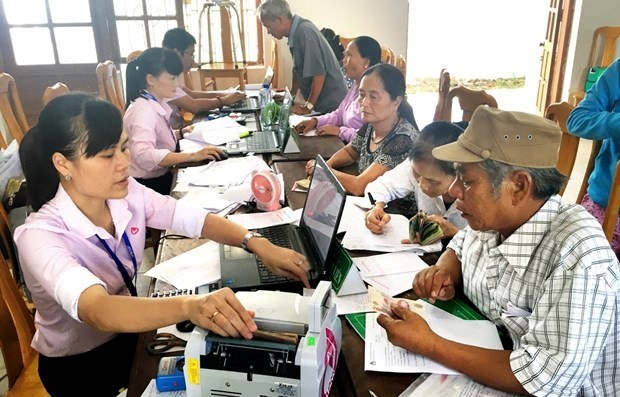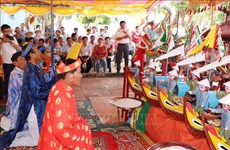Twenty years doing social policy credit wholeheartedly
Officially launched and put into operation on October 4, 2002, the Viet Nam Bank for Social Policies - as the "extension arm" of the Government - has worked hard to bring preferential capital to the poor and other policy beneficiaries – in a 20-year journey full of hardship, sweat and even tears of thousands of officials and employees in the system.
 Over the past 20 years, more than 42 million households have received policy loans to get out of poverty and get rich legally. (Photo: Vietnam+)
Over the past 20 years, more than 42 million households have received policy loans to get out of poverty and get rich legally. (Photo: Vietnam+)Policy credit employees stay closely connected to villagers
In early 2002, the poverty rate among households nationwide was nearly 30%. The main operating areas of the bank were in areas with special difficulties and underdeveloped infrastructure. The poor transport conditions in mountainous communes along with the different cultures of ethnic minority groups and their self-sufficient production practices deeply rooted through various generations, made the task of bringing credit to these communities all the more challenging.
Therefore, the Bank for Social Policies has closely coordinated with four socio-political organizations: Vietnam Women's Union, Vietnam Farmer's Union, Vietnam War Veterans’ Association and Ho Chi Minh Communist Youth Union to provide and manage credit capital under specific social policies.
The bank has, together with the entrusted socio-political organizations, conducted communication activities to encourage and guide people to borrow capital and change their economic development mindset. The bank also integrated social policy capital with local economic development programmes. What is even more important is to monitor borrowers in using capital, guide them in how to use capital effectively for the right purposes, and recover capital.
In many localities, the Bank for Social Policies credit officers have been present in the most difficult areas to, along with border guards and local government, help local resident rise out of hunger and poverty.
The commune transaction point with a fixed monthly transaction date is a breakthrough initiative of the Bank for Social Policies, a step forward in administrative reform, bringing policy capital to people in remote areas timely according to the motto "transactions at home, disbursement and debt collection at the commune office."
However, operating this model requires hard work and great sacrifices of the bank’s employees who work even on weekends and travel to remote areas daily regardless of weather conditions.
However, the Bank for Social Policies staffs have not refused an assignment or left work because of difficulties. Even in 2021, when the COVID-19 epidemic spread on a large scale throughout the country, many employees of the bank in southern provinces did not return their home for most of the year.
In particular, in the context of rapid and strong economic development of the country, the Government has five times raised the poverty line, as well as expanded the scope of beneficiaries of the policy on social policy credit to ensure social security and reduce sustainable poverty, speeding up the process of national economic development and integration.
The "extended arm" of the weak
The Bank for Social Policies not only promotes its role as an "extension arm" of the Government, implementing social credit policies, but also gradually takes up a role as a "bridge" connecting the poor and disadvantaged people with State and Government agencies. The bank has proposed and advised on the issuance of many new credit programmes, raising the loan level to meet the needs of the people.
By now, from the initial two credit programmes, the Bank for Social Policies is implementing 22 credit programmes in 100% of communes, wards and townships nationwide to help the poor and other policy beneficiaries to steadily develop the household economy and improve their living conditions.
According to a report of the Bank for Social Policies, over the past 20 years, more than 42 million households have received loans worth over 814,000 billion VND; contributing to reducing the national poverty rate in the period 2011-2015 from 14.2% to 4.25% (based on the poverty line for the period 2011-2015); and bringing the rate of multi-dimensionally poor households down from 9.88% (in 2016) to 2.75% (in 2020). All of these efforts have helped turn Vietnam into a bright spot in the implementation of the Millennium Development Goals on poverty reduction recognized by the world.
However, the cause of poverty reduction is still difficult because the “core of poverty” is concentrated in ethnic minority and mountainous areas, especially in the northern midlands and mountains, where the poverty rate is the highest in the country (13.4%). The level of inequality in income distribution is higher in rural areas than in urban areas. The two regions with high poverty rates, the northern midlands and mountains and the Central Highlands, are also the two regions with high GINI coefficients (the coefficient to show income inequality across many regions, classes of a country) of 0.428 and 0.418 respectively. The southeast region has the lowest GINI coefficient at 0.322.
To accelerate the process of sustainable poverty reduction, in addition to poverty reduction, the Bank for Social Policies also focuses attention on job creation and livelihoods, and student loans. These will be the driving forces to further the implementation of two national target programmes, and promote the country's rapid and sustainable economic growth towards becoming a high-income country by 2045./.











